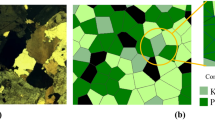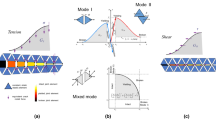Abstract
As the excavation depth of underground engineering increases, the influence of in situ stress on the blasting effect cannot be ignored. The large number of fractures in the natural rock mass, coupled with the in situ stress, significantly impacts the propagation of stress waves. In this research, a synthetic rock mass approach based on the UDEC grain-based model was employed to investigate crack propagation and coalescence during double-borehole blasting with a variety of fracture networks and in situ stress conditions. The effects of the buried depth, fracture geometric parameters (i.e., the length and intensity), blast parameters (i.e., the explosive charge and borehole spacing), and borehole layouts on blasting-induced rock fracturing were examined. The simulation results showed that for a low-density fracture network dominated by short fractures, the pre-existing fractures have little effect on the propagation of blasting-induced cracks. However, as the length or density of fractures increases, pre-existing fractures could restrain the blasting-induced radial crack propagation and enhance the rock fragmentation between the borehole and the pre-existing fracture. This effect gradually disappeared as the in situ stress increased. In addition, the mismatch between the centreline of double boreholes and the direction of high in situ stress could also affect the coalescence of cracks, especially in high-density fracture networks. Finally, the applicability of empty holes to improve the crack coalescence between boreholes in fractured rock was discussed. This study should be beneficial in understanding the blasting behaviour of deep fractured rocks.
Article Highlights
-
1.
The synthetic rock mass method was used to examine the crack coalescence process of double-borehole blasting.
-
2.
The effects of the buried depth, fracture geometric parameters, blast parameters, and borehole layouts on blasting-induced rock fractures were investigated.
-
3.
The applicability of empty holes to improve the crack coalescence between boreholes in fractured rock was discussed.














Similar content being viewed by others
Explore related subjects
Discover the latest articles, news and stories from top researchers in related subjects.Abbreviations
- \(k_{n}\) :
-
Normal stiffness
- \(k_{s}\) :
-
Shear stiffness
- \(\Delta u_{n}\) :
-
Normal displacement increment
- \(\Delta u_{s}^{e}\) :
-
Elastic shear displacement increment
- \(\Delta \sigma_{n}\) :
-
Effective normal stress increment
- \(\Delta \tau_{s}\) :
-
Effective shear stress increment
- \(\tau_{s}\) :
-
Shear stress
- \(\tau_{\max }\) :
-
Peak shear strength
- \(\tau_{r}\) :
-
Residual shear strength
- c :
-
Cohesion
- \(c_{r}\) :
-
Residual cohesion
- \(\phi\) :
-
Friction angle
- \(\phi_{r}\) :
-
Residual friction angle
- α :
-
Proportionality coefficient
- a :
-
Fracture length exponent.
- P 21 :
-
Areal fracture intensity
- \(\sigma_{v}\) :
-
Vertical stress
- \(\sigma_{h}\) :
-
Horizontal stress
- \(\sigma_{h\max }\) :
-
Maximum horizontal principal stress
- \(\sigma_{h\min }\) :
-
Minimum horizontal principal stress
- \(\gamma\) :
-
Bulk density of the rock mass
References
Cho SH, Nakamura Y, Mohanty B et al (2008) Numerical study of fracture plane control in laboratory scale blasting. Eng Fract Mech 75:3966–3984. https://doi.org/10.1016/j.engfracmech.2008.02.007
Dehghan Banadaki MM, Mohanty B (2012) Numerical simulation of stress wave induced fractures in rock. Int J Impact Eng 40–41:16–25. https://doi.org/10.1016/j.ijimpeng.2011.08.010
Fan LF, Zhou XF, Wu ZJ, Wang LJ (2019) Investigation of stress wave induced cracking behavior of underground rock mass by the numerical manifold method. Tunn Undergr Space Technol 92:103032. https://doi.org/10.1016/j.tust.2019.103032
Fu TF, Xu T, Heap MJ et al (2020) Mesoscopic time-dependent behavior of rocks based on three-dimensional discrete element grain-based model. Comput Geotech 121:103472. https://doi.org/10.1016/j.compgeo.2020.103472
Ghasemi S, Khamehchiyan M, Taheri A et al (2020) Crack evolution in damage stress thresholds in different minerals of granite rock. Rock Mech Rock Eng 53:1163–1178. https://doi.org/10.1007/s00603-019-01964-9
Grenon M, Bruneau G, Kapinga Kalala I (2014) Quantifying the impact of small variations in fracture geometric characteristics on peak rock mass properties at a mining project using a coupled DFN-DEM approach. Comput Geotech 58:47–55. https://doi.org/10.1016/j.compgeo.2014.01.010
He C, Yang J (2019) Experimental and numerical investigations of dynamic failure process in rock under blast loading. Tunn Undergr Space Technol 83:552–564. https://doi.org/10.1016/j.tust.2018.08.047
He M, Gong W, Wang J et al (2014) Development of a novel energy-absorbing bolt with extraordinarily large elongation and constant resistance. Int J Rock Mech Min Sci 67:29–42. https://doi.org/10.1016/j.ijrmms.2014.01.007
Holloway DC (1982) Application of holographic interferometry to stress wave and crack propagation problems. Opt Eng 21(3):468–473. https://doi.org/10.1117/12.7972931
Hu XD, Zhao GF, Deng XF et al (2018) Application of the four-dimensional lattice spring model for blasting wave propagation around the underground rock cavern. Tunn Undergr Space Technol 82:135–147. https://doi.org/10.1016/j.tust.2018.08.006
Kazerani T, Zhao J (2014) A microstructure-based model to characterize micromechanical parameters controlling compressive and tensile failure in crystallized rock. Rock Mech Rock Eng 47:435–452. https://doi.org/10.1007/s00603-013-0402-y
Lei Q, Latham JP, Tsang CF (2017) The use of discrete fracture networks for modelling coupled geomechanical and hydrological behaviour of fractured rocks. Comput Geotech 85:151–176. https://doi.org/10.1016/j.compgeo.2016.12.024
Li JC, Li HB, Ma GW (2010) Zhao J (2010) An equivalent 1d dynamic continuum model for rock mass with parallel joints. Chin J Rock Mech Eng 29(s2):4063–4067 ((in Chinese))
Li JC, Li NN, Li HB, Zhao J (2017a) An SHPB test study on wave propagation across rock masses with different contact area ratios of joint. Int J Impact Eng 105:109–116. https://doi.org/10.1016/j.ijimpeng.2016.12.011
Li X, Zhang QB, He L, Zhao J (2017b) Particle-based numerical manifold method to model dynamic fracture process in rock blasting. Int J Geomech 17:1–20. https://doi.org/10.1061/(asce)gm.1943-5622.0000748
Li JC, Rong LF, Li HB, Hong SN (2018) An SHPB test study on stress wave energy attenuation in jointed rock masses. Rock Mech Rock Eng 52:403–420. https://doi.org/10.1007/s00603-018-1586-y
Li X, Zhu Z, Wang M et al (2021a) Numerical study on the behavior of blasting in deep rock masses. Tunn Undergr Space Technol 113:103968. https://doi.org/10.1016/j.tust.2021.103968
Li Z, Li J, Li H, Zhao J (2021b) Effects of a set of parallel joints with unequal close-open behavior on stress wave energy attenuation. Waves Random Complex Media 31(6):2427–2451. https://doi.org/10.1080/17455030.2020.1748754
Ma GW, An XM (2008) Numerical simulation of blasting-induced rock fractures. Int J Rock Mech Min Sci 45:966–975. https://doi.org/10.1016/j.ijrmms.2007.12.002
Mohanty B (1990) Explosion generated fractures in rock and rock-like materials. Eng Fract Mech 35:889–898. https://doi.org/10.1016/0013-7944(90)90173-E
Pan C, Li X, He L, Li J (2021) Study on the effect of micro-geometric heterogeneity on mechanical properties of brittle rock using a grain-based discrete element method coupling with the cohesive zone model. Int J Rock Mech Min Sci 140:104680. https://doi.org/10.1016/j.ijrmms.2021.104680
Ranjith PG, Zhao J, Ju M et al (2017) Opportunities and challenges in deep mining: a brief review. Engineering 3:546–551. https://doi.org/10.1016/J.ENG.2017.04.024
Shang J, Hencher SR, West LJ (2016) Tensile strength of geological discontinuities including incipient bedding, rock joints and mineral veins. Rock Mech Rock Eng 49:4213–4225. https://doi.org/10.1007/s00603-016-1041-x
Singh SP, Xavier P (2005) Causes, impact and control of overbreak in underground excavations. Tunn Undergr Space Technol 20:63–71. https://doi.org/10.1016/j.tust.2004.05.004
Sun Z, Jiang C, Wang X et al (2020) Joint influence of in-situ stress and fracture network geometry on heat transfer in fractured geothermal reservoirs. Int J Heat Mass Transf 149:119216. https://doi.org/10.1016/j.ijheatmasstransfer.2019.119216
Wang Y, Yang R, Zhao G (2017) Influence of empty hole on crack running in PMMA plate under dynamic loading. Polym Test 58:70–85. https://doi.org/10.1016/j.polymertesting.2016.11.020
Wang X, Yuan W, Yan Y, Zhang X (2020) Scale effect of mechanical properties of jointed rock mass: a numerical study based on particle flow code. Geomech Eng 21:259–268. https://doi.org/10.12989/gae.2020.21.3.259
Xie LX, Lu WB, Zhang QB et al (2017) Analysis of damage mechanisms and optimization of cut blasting design under high in-situ stresses. Tunn Undergr Space Technol 66:19–33. https://doi.org/10.1016/j.tust.2017.03.009
Xu C, Fu Q, Cui X et al (2019) Apparent-depth effects of the dynamic failure of thick hard rock strata on the underlying coal mass during underground mining. Rock Mech Rock Eng 52:1565–1576. https://doi.org/10.1007/s00603-018-1662-3
Xu T, Fu TF, Heap MJ et al (2020) Mesoscopic damage and fracturing of heterogeneous brittle rocks based on three-dimensional polycrystalline discrete element method. Rock Mech Rock Eng 53:5389–5409. https://doi.org/10.1007/s00603-020-02223-y
Yi C, Johansson D, Greberg J (2018) Effects of in-situ stresses on the fracturing of rock by blasting. Comput Geotech 104:321–330. https://doi.org/10.1016/j.compgeo.2017.12.004
Yuan W, Liu S, Wang W et al (2019) Numerical study on the fracturing mechanism of shock wave interactions between two adjacent blast holes in deep rock blasting. Earthq Eng Eng Vib 18:735–746. https://doi.org/10.1007/s11803-019-0533-6
Zhao XB, Zhao J, Cai JG, Hefny AM (2008) UDEC modelling on wave propagation across fractured rock masses. Comput Geotech 35:97–104. https://doi.org/10.1016/j.compgeo.2007.01.001
Zhao JJ, Zhang Y, Ranjith PG (2017) Numerical simulation of blasting-induced fracture expansion in coal masses. Int J Rock Mech Min Sci 100:28–39. https://doi.org/10.1016/j.ijrmms.2017.10.015
Zhou GL, Xu T, Konietzky H et al (2022) An improved grain-based numerical manifold method to simulate deformation, damage and fracturing of rocks at the grain size level. Eng Anal Bound Elem 134:107–116. https://doi.org/10.1016/j.enganabound.2021.10.005
Zhu J, Li Y, Peng Q et al (2021) Stress wave propagation across jointed rock mass under dynamic extension and its effect on dynamic response and supporting of underground opening. Tunn Undergr Space Technol 108:103648. https://doi.org/10.1016/j.tust.2020.103648
Acknowledgements
This work is financially supported by the National Natural Science Foundation of China (Grant No. 11802058, 41831281) and the Open Research Fund of State Key Laboratory of Geomechanics and Geotechnical Engineering, Institute of Rock and Soil Mechanics, Chinese Academy of Sciences (Grant No. Z018010). The valuable discussions with Prof. Jianchun Li at Southeast University throughout this study are gratefully acknowledged.
Author information
Authors and Affiliations
Corresponding author
Ethics declarations
Conflict of interest
All authors declare that they have no conflict of interest.
Additional information
Publisher's Note
Springer Nature remains neutral with regard to jurisdictional claims in published maps and institutional affiliations.
Rights and permissions
About this article
Cite this article
Li, X., Pan, C., Li, X. et al. Application of a synthetic rock mass approach to the simulation of blasting-induced crack propagation and coalescence in deep fractured rock. Geomech. Geophys. Geo-energ. Geo-resour. 8, 57 (2022). https://doi.org/10.1007/s40948-022-00376-4
Received:
Accepted:
Published:
DOI: https://doi.org/10.1007/s40948-022-00376-4




